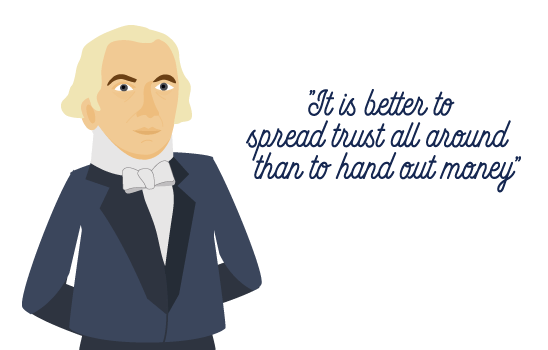Following the War of 1812, America was more united, politically, than they had been in many years. It was in this time of relative stability that Monroe came to power in the U.S. His presidency was one of immense growth for the country, although it was not without growing pains. As a war veteran, previous governor, long-time politician, and foreign ambassador, Monroe had all the qualifications for the office of president. And he would ultimately need each one to handle the ever-evolving conditions of a young country. In this unit study supplement, you’ll get answers to many questions you may have about the fifth president of the U.S. If you want to discover what James Monroe is known for, read on the numerous accomplishments, military and political service, personal life, and more.
Boost your social studies expertise with our growing series of presidential unit study supplements.
James Monroe Fast Facts
| Presidential Order | 5th President |
|---|---|
| Political Party | Democratic-Republican |
| Born | April 28, 1758 |
| Death | July 4, 1831 |
| State of Birth | Virginia |
| Name of Spouse | Elizabeth Kortright |
| Served as President | 1817-1825 |
| Age When Elected to Office | 58 years old |
| Vice Presidents | Daniel D. Tompkins |
I was bold in the pursuit of knowledge, never fearing to follow truth and reason to whatever results they led, and bearding every authority which stood in their way.
James Monroe Timeline
1758
Born on April 28, 1758 in Virginia into a moderately prosperous household.
1769
Began attending formal school at the age of 11, but was only able to attend less than three months a year because of farming duties.
1774
Became orphaned at the age of 16 and was forced to withdraw from school altogether to support his younger siblings.
1776
Joined the 3rd Virginia Regiment in the Continental Army of the American Revolution. While fighting in the Battle of Trenton under General George Washington, he nearly died due to a bullet injury.
1777-78
After recovering from his injury, he rejoined the Revolutionary War and was encamped at Valley Forge.
1779
Returned to Virginia to study law and became an apprentice to VA governor Thomas Jefferson.
1783
Sold his inherited Virginia plantation and began to practice law after being admitted to the VA bar. Also began serving in the Continental Congress for the state of VA (a predecessor of our current Congress)
1786
Married Elizabeth Kortright of New York City, who he had met while serving in the Continental Congress.
1790
Served as VA senator following the death of the original elected representative.
1794
Appointed as Ambassador to France where he focused on protecting U.S. trade interests, garnering U.S. navigation rights in the Mississippi River, and the right to use the port in New Orleans.
1796
Returned to Virginia to focus on his plantation and to resume practicing law.
1799
Elected Governor of Virginia. During his tenure he created the state’s first penitentiary and suppressed a slave rebellion.
1803
Traveled to France to help the current French Ambassador negotiate the Louisiana Purchase. Also was appointed as Ambassador to Great Britain.
1811
Briefly served a four-month second term as Governor of VA, but then was appointed Secretary of State by President James Madison.
1814
Was appointed Secretary of War during the hard-fought War of 1812.
1816
Elected United States president with over 80% of the electoral vote. Key accomplishments during his eight year tenure included solidifying the northern border of the new Louisiana territory, dealing with the Panic of 1819 (an economic depression), improving national infrastructure, quashed Seminole uprisings, and acquired the Florida territories from Spain.
1823
In a message to Congress, he outlined a strong position that no more European countries should be allowed to colonize any country in North or South America, and if they tried, it would be considered an act of war. This policy was eventually named “The Monroe Doctrine.”
1825
Began serving on the Board of the newly formed University of Virginia in Charlottesville.
1830
Moved to New York City to live with his daughter following the death of his wife.
1831
Died on July 4 of heart failure and tuberculosis complications.
James Monroe: Fun Facts
Any James Monroe unit study should focus on his main personal, political, and historical accomplishments. However, homeschoolers will also enjoy discovering some of the lesser known facts about the 5th President of the United States.
-
He is the only person ever to serve in dual roles as Secretary of State and Secretary of War at the same time.
-
During Monroe’s presidency, five new states were added to the Union: Mississippi, Illinois, Alabama, Maine, and Missouri.
-
While he was Governor of Virginia, a large group of slaves hatched a plan to kidnap him and ransom him for their freedom, but the plan never unfolded. Monroe learned about it, however, and set out slave patrols to capture those known to be involved. Dozens of slaves were hanged, even though the uprising never occurred.
-
The capital city of Liberia in Africa is named after Monroe (Monrovia) in honor of his part in creating settlements for freed American slaves there. It is the only capital city named after a U.S. president outside of America.
-
A city in each of the states of Alabama, Massachusetts, New Jersey, Ohio, and Virginia are also named after the president.
-
In a “heated” exchange between himself and his Treasury Secretary, the secretary shook his cane at the President and Monroe responded by pulling a set of red hot tongs from his fire to defend himself. They never came to blows, but they also never spoke again.
-
Because he was the last president to don a powdered wig and a tricorn hat, he was nicknamed “The Last Cocked Hat.”
-
His daughter, Maria, was married in the first ever wedding at the White House.
-
Because there was less partisan hostility, the period of Monroe’s presidency is often called “The Era of Good Feelings.”
-
He is the last president that was never photographed.
-
Monroe was one of three presidents to have died on Independence Day. The other two are John Adams and Thomas Jefferson.
Hands-On Activities for James Monroe Unit Study
Now that you’ve learned the main President James Monroe facts, try out some of these ideas, which we’ve organized by grade level, to enhance your unit study of the 5th president of the United States.
Elementary James Monroe Activities
-
After getting familiar with the life of James Monroe — important events, accomplishments, and political leanings — have your student use a T-Chart graphic organizer to outline what they believe are the positive and negative sides of his life and presidency.
-
Download a printable U.S. map and have your elementary school student locate, color in, and mark the capital for each of the five states added to America during the presidency of James Monroe.
Middle School James Monroe Activities
-
War was an ongoing theme in the life of President Monroe. He fought in the American Revolution and was a key strategy maker for the War of 1812. Have your middle schooler choose one of those key conflicts and research it well enough to create a timeline of the events that led the opposing parties to resort to war to resolve the issues.
-
Figuring out the odds of a specific event is a great way to practice fractions and ratios. Determining odds of any event is simply the ratio of the ways an outcome can occur versus the ways an outcome cannot occur. Three American Presidents died on July 4. Have your middle schooler determine the odds of that event happening. (Hint: it involves knowing how many presidents we’ve had and the number of days in a year.)
High School James Monroe Activities
-
After the Louisiana Purchase was signed, French leader Napoleon said, “This accession of territory affirms forever the power of the United States.” Write a short persuasive essay either confirming or denying the truth of Napoleon’s declaration.
-
Your high schooler can access the full Monroe Doctrine speech online. Have them locate each of the countries mentioned in the speech on a world map and do research to determine how much land each of those countries had rights to in the year 1823 when the speech occurred.
Quick James Monroe Spelling Words
| doctrine | partisan |
| apprentice | uprising |
| plantation | electoral |
| penitentiary | government |
| infrastructure | colonize |







